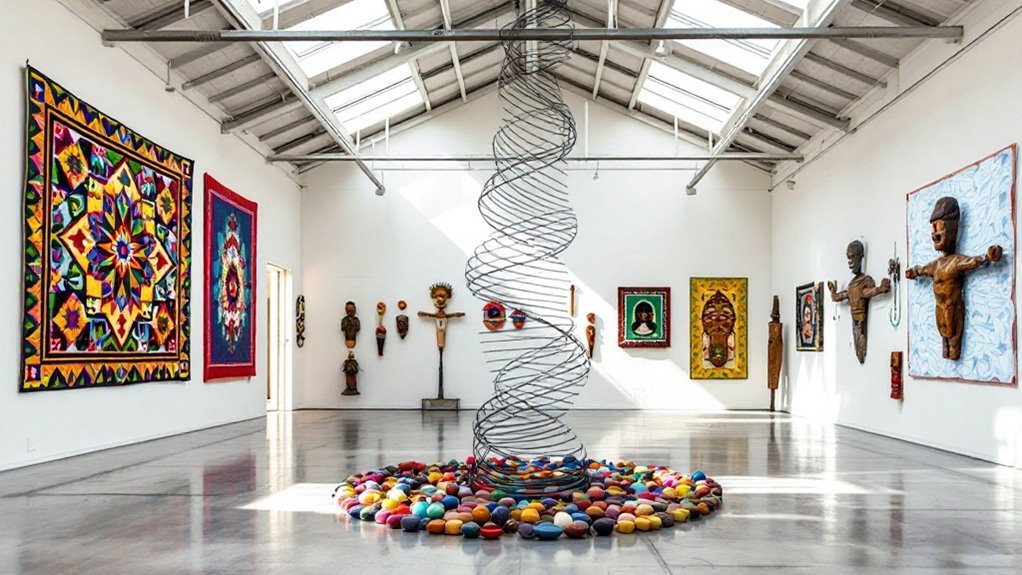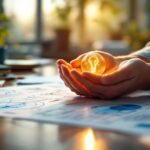The Museum of Folk Art in Manhattan has preserved American folk traditions since 1961. Its collection of over 7,000 pieces spans traditional quilts, weathervanes, and contemporary self-taught art. The museum pairs historical artifacts with modern installations, creating dynamic exhibitions that bridge past and present. Virtual reality experiences and digital initiatives enhance visitor engagement. This innovative approach to folk art preservation continues to shape cultural understanding through unexpected connections.
Key Takeaways
- Manhattan’s Museum of Folk Art houses over 7,000 pieces spanning traditional and contemporary folk art since its 1961 founding.
- Exhibitions uniquely blend historical pieces like antique quilts and weathervanes with modern installations and kinetic sculptures.
- The museum features works from renowned folk artists including Henry Darger and Sister Gertrude Morgan.
- Virtual reality technology allows visitors to experience historical artisan workshops while exploring traditional folk art methods.
- Educational programs and research initiatives actively connect historical folk traditions with contemporary artistic interpretations.
A Legacy of Folk Art Excellence: Six Decades of Cultural Preservation
Dedication to preserving American folk art has defined the Museum of Folk Art since its founding in 1961. Located in Manhattan, the institution has amassed over 7,000 pieces representing diverse folk traditions across multiple generations of artists.
The museum’s collection spans traditional quilts, weathervanes, and carved figures to contemporary self-taught art. Through carefully curated exhibitions, educational programs, and conservation efforts, it has established itself as a leading institution in folk art preservation.
Notable exhibitions have showcased works from renowned artists like Henry Darger and Sister Gertrude Morgan.
The museum’s commitment extends beyond mere display, encompassing research initiatives and community outreach that connect modern audiences with folk art heritage. Its archive serves as an essential resource for scholars, artists, and cultural historians studying American folk traditions.
Bridging Past and Present: Innovative Exhibits That Define American Folk Art
The Museum of Folk Art masterfully weaves historical and contemporary folk art through groundbreaking exhibitions that challenge traditional boundaries.
Through carefully curated displays, the museum showcases both time-honored techniques and modern interpretations of folk traditions, creating dynamic dialogues between different eras.
Recent exhibitions have paired 18th-century quilts with contemporary fiber installations, while weathervanes and whirligigs from early American craftsmen stand alongside modern kinetic sculptures.
The museum’s innovative approach extends to its digital initiatives, where virtual reality experiences allow visitors to step into the workshops of historical artisans.
Through these thoughtful juxtapositions, the museum illustrates how folk art continues to evolve while maintaining its core essence of cultural expression and community storytelling.
FAQ
Does the Museum Offer Guided Tours in Languages Other Than English?
The museum provides guided tours in multiple languages, including Spanish, Mandarin, French, and German.
These tours must be scheduled at least two weeks in advance through the visitor services desk.
Audio guides are also available in six different languages for self-guided exploration.
For groups of 10 or more, specialized language tours can be arranged with certified multilingual docents.
What Are the Museum’s Policies Regarding Photography and Sketching?
Photography without flash is permitted in most permanent collection galleries, but may be restricted in special exhibitions.
Visitors can take photos for personal use only, not commercial purposes.
Sketching with pencils and small sketchbooks is allowed in all galleries, though easels and wet materials are prohibited.
Tripods and selfie sticks require advance permission from museum staff.
Is There a Café or Restaurant Inside the Museum?
While bustling art enthusiasts browse galleries above, hungry visitors can find respite at the museum’s charming M. Café located on the ground floor.
The café offers a thoughtfully curated menu of light meals, pastries, and beverages in a modern setting adorned with folk art pieces.
Operating during regular museum hours, it provides both indoor seating and a small outdoor terrace when weather permits.
Advance reservations are not required.
Are There Special Rates for Students and Senior Citizens?
The museum offers discounted admission rates for both students and seniors with valid identification.
Students aged 18 and above can receive a reduced entry fee of $9, while senior citizens aged 65 and older pay $8. These special rates represent significant savings compared to the regular adult admission price of $12.
Group rates are also available for student tours and senior groups.
Does the Museum Offer Art-Making Workshops for Children and Families?
With over 2,000 children participating annually, art-making workshops have become a cornerstone of family programming.
The museum offers weekend workshops where children ages 4-12 and their families can learn traditional folk art techniques like paper cutting, weaving, and pottery.
Sessions run twice monthly on Saturdays, with special holiday-themed workshops during festive seasons.
Advanced registration is required, and materials are included in the workshop fee.






